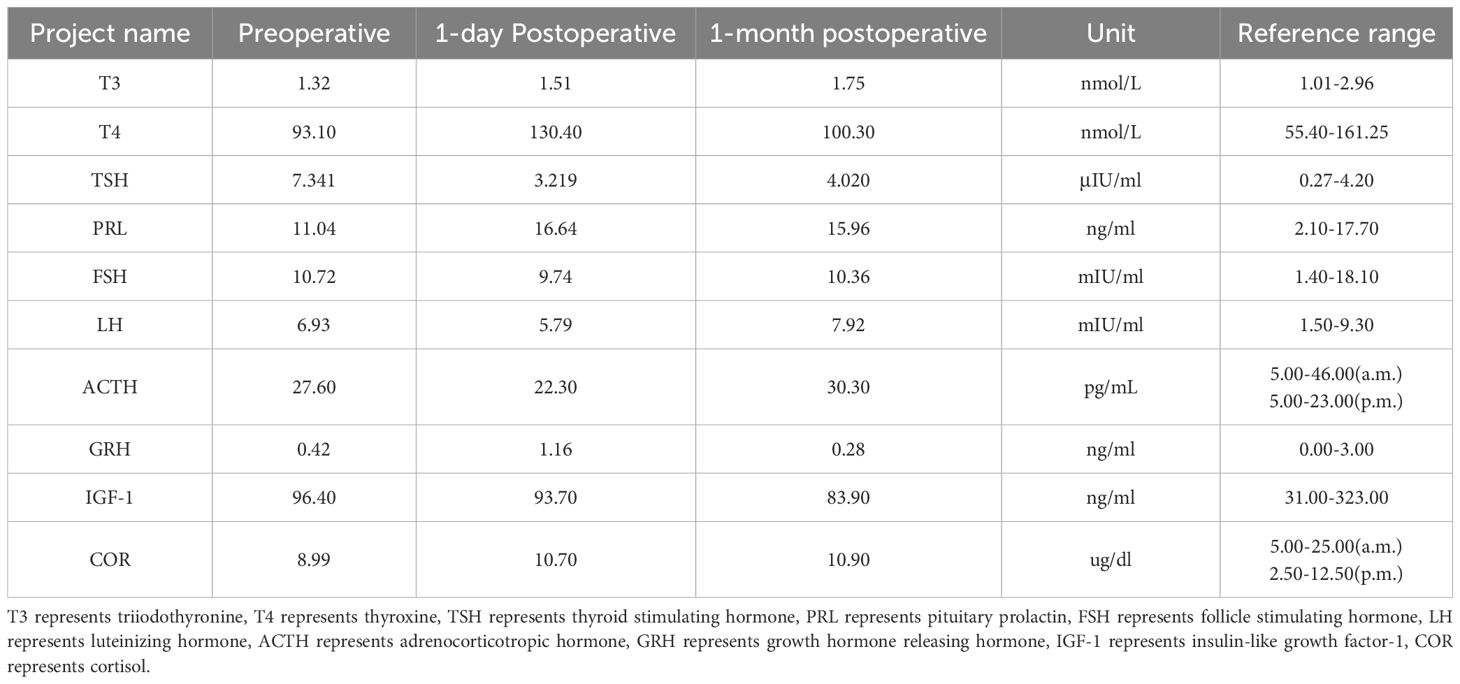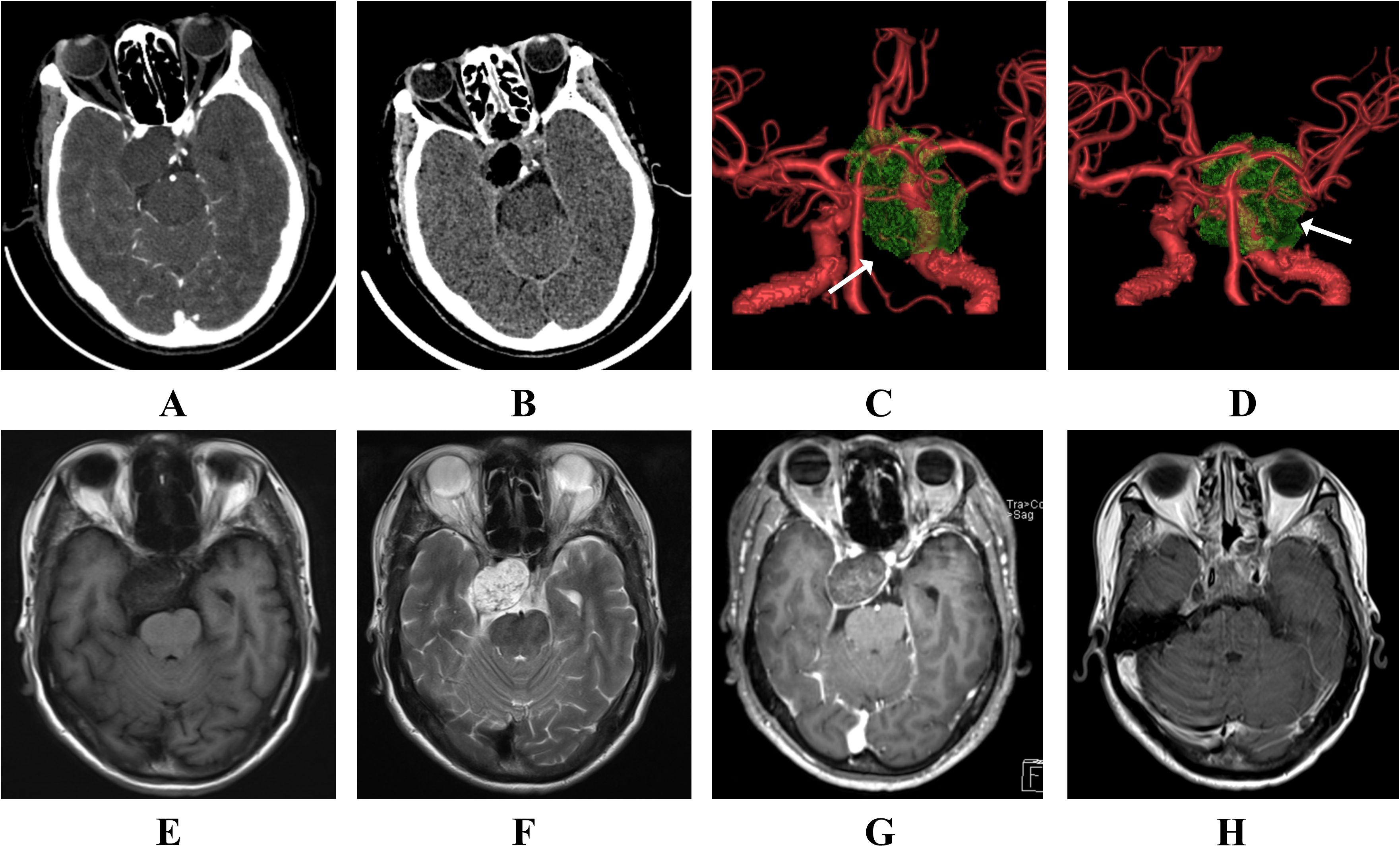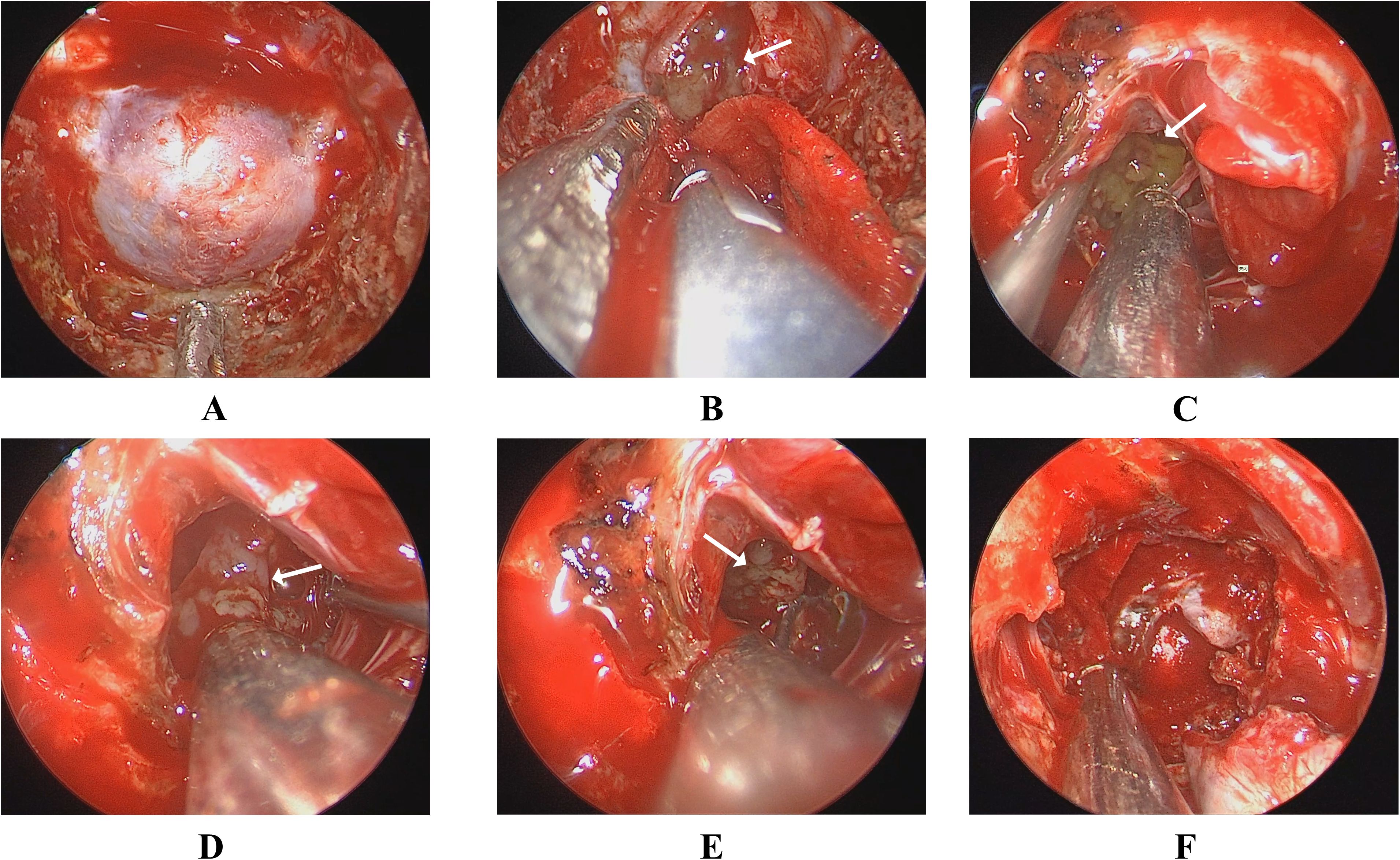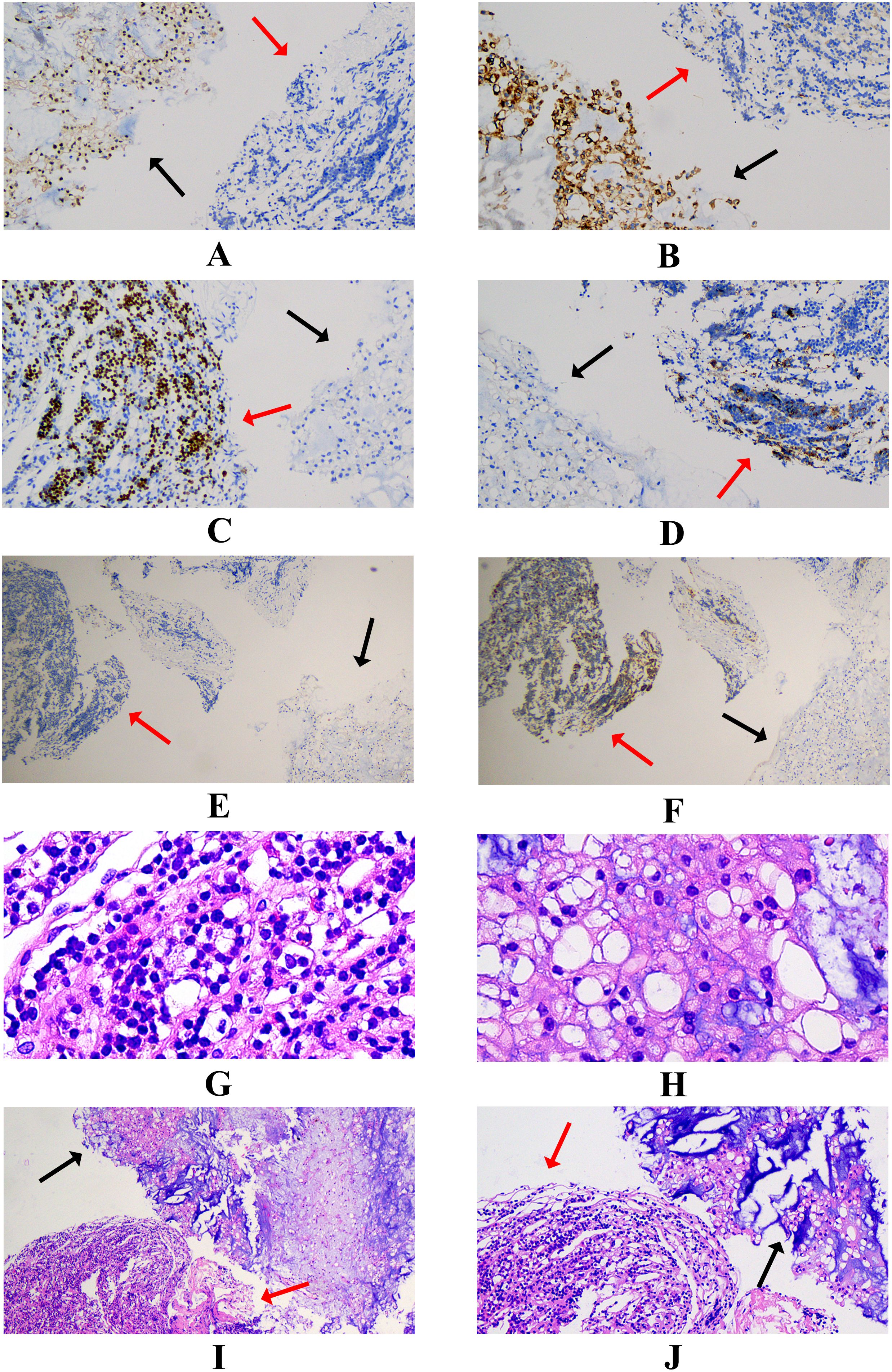- 1Department of Neurosurgery, The Second Hospital & Clinical Medical School, Lanzhou University, Gansu, China
- 2Department of Pathology, The Second Hospital & Clinical Medical School, Lanzhou University, Gansu, China
- 3Department of Emergency, Qingyang Xifeng District People’s Hospital, Gansu, China
Collision tumors are relatively rare and refer to the coexistence of distinct tumors in the same anatomical region, where they invade each other. Sellar collision tumors are especially uncommon. Recent studies suggest that most cases involve the coexistence of pituitary adenomas and craniopharyngiomas, whereas collision tumors comprising pituitary adenomas and chordomas are exceedingly rare. To the best of our knowledge, this case represents the fourth reported instance of an intrasellar chordoma coexisting with a pituitary adenoma. This case report presents a 60-year-old male patient with a collision tumor consisting of a sellar chordoma and a pituitary adenoma. Enhanced MRI identified a large space-occupying lesion involving the sellar region, suprasellar area, and third ventricle, suspected to be a soft tissue chordoma. Histopathological examination following endoscopic transnasal surgery confirmed the diagnosis of a sellar chordoma coexisting with a pituitary adenoma. This case offers valuable insights into the clinical manifestations and imaging characteristics of sellar chordoma coexisting with pituitary adenoma, contributing to a better understanding of this rare condition. Furthermore, this article reviews the existing literature, serving as a reference for the diagnosis and management of such conditions.
Introduction
Sellar chordoma is a rare malignant tumor that typically arises from notochordal remnants. Its incidence is low, comprising approximately 1% of all malignant bone tumors and 0.2% of intracranial tumors (1, 2), Most sellar chordomas originate from bones adjacent to or superior to the sella turcica, within the axial skeleton (3). The clinical manifestations of chordoma are primarily associated with tumor growth and invasion, frequently leading to neurological symptoms such as visual impairment, headache, and vomiting (4). Pituitary adenomas are common benign brain tumors, with an incidence of approximately 1 in 1100, typically manifesting as endocrine dysfunction and frequently detected early via imaging studies (5). The concurrent occurrence of sellar chordoma and pituitary adenoma is exceptionally rare in clinical practice (6). To the best of our knowledge, this case represents the fourth reported instance of intrasellar chordoma coexisting with a pituitary adenoma worldwide (6–8). Given the overlapping clinical symptoms of these two tumor types, misdiagnosis or delayed diagnosis is possible. When two histologically distinct tumors coexist in the same anatomical region and invade each other, this phenomenon is termed a collision tumor (9, 10). Despite extensive theoretical discussions on the pathophysiological mechanisms of collision tumors, clinical experience and research data remain limited due to the rarity of sellar collision tumors (9). This study seeks to enhance our understanding of the rare coexistence of sellar chordoma and pituitary adenoma by detailing the clinical presentation, imaging findings, pathological characteristics, and treatment course of this case, thereby providing a reference for future clinical diagnosis and management.
Case report
A 60-year-old male patient presented to the hospital with a two-month history of headache, dizziness, nausea, vomiting, and blurred vision in the right eye. The patient had no history of chronic diseases and no prior surgical history. He had a smoking history of over 20 years and no known family history of genetic disorders. Physical examination identified a temporal visual field defect in the right eye. Subsequent visual acuity, visual field, and fundus examinations confirmed reduced vision in the right eye compared to the left, with a significant temporal visual field defect ranging from 20° to 30°. Fundus examination revealed no direct lesions. The pituitary and target gland hormones were measured. Endocrine evaluation indicated an elevated thyroid-stimulating hormone (TSH) level (7.341 μIU/ml; reference range: 0.27–4.20 μIU/ml) (Table 1), while other hormones were within normal limits. The remainder of the physical examination was unremarkable. Routine blood tests and biochemical analyses, including blood chemistry and electrolyte levels, showed no significant abnormalities on admission.

Table 1. Preoperative refers to the endocrine indicator tests conducted upon the patient’s admission, while Postoperative denotes the endocrine indicator tests performed within 24 hours after the patient’s surgery.
The cranial computed tomography (CT) scans reveal bone destruction in the dorsum sellae, indicative of the chordoma (Figure 1A). The patient’s CT angiography (CTA) examination revealed a tumor encircling the cavernous segment of the right internal carotid artery (Figures 1C, D). Magnetic Resonance Imaging (MRI) showed a roughly oval-shaped mass measuring approximately 23mm×34mm×37mm in the sellar region, suprasellar area, and the third ventricle (Figure 1G). On T1-weighted imaging (T1WI), the tumor appeared hypointense with punctate and flaky slightly hyperintense areas (Figure 1E), while on T2-weighted imaging (T2WI), it was predominantly hyperintense with local punctate and flaky hypointense areas (Figure 1F). The patient was diagnosed with a sellar chordoma, subsequently underwent endoscopic endonasal surgery. However, during the operation, two different types of tumors were found in the sella turcica (Figure 2). The tumor tissue near the pituitary structure was soft, pale yellow (Figures 2B, C), while the tumor near the clivus position was grayish-white and harder in texture (Figures 2D, E). A near-total resection of the tumors was performed. Histopathological results confirmed two different tumors(Figure 3): Brachyury (Chordoma+), EMA (Chordoma+), CK8/18 (Chordoma and Pituitary neuroendocrine tumor), CKp (Chordoma and Pituitary neuroendocrine tumor+), PIT-1 (Pituitary neuroendocrine tumor+), GH (+), PRL (Focal +/-), Syn (Pituitary neuroendocrine tumor+), Vimentin (+), GFAP (-), Olig-2 (-), S-100 (-), p53 (Wild type), CK5/6 (Focal +/-), T-PIT (-), SF-1 (-), FSH (-), Ki67 (3%+), ACTH (Focal +/-), TSH (-), LH (-). Therefore, based on histopathology, the final diagnosis in this case was sellar chordoma combined with a PIT-1 lineage pituitary adenoma.

Figure 1. (A) shows the patient’s preoperative cranial CT scan, (B) shows the postoperative cranial CT scan within 24 hours; (C, D) represent the patient’s preoperative cranial CTA images, indicates the tumor invaded the cavernous sinus and encased the right internal carotid artery; (E, F) represents the patient’s preoperative MRI T1-weighted imaging (T1WI) and MRI T2-weighted imaging (T2WI), respectively; (G) shows the preoperative contrast-enhanced MRI of the patient; (H) shows contrast-enhanced MRI at 48 hours postoperatively.

Figure 2. (A) shows the intraoperative exposure of the sellar floor; (B, C) shows the pale yellow tumor near the pituitary stalk and the third ventricle during surgery; (D, E) shows the tumor near the clivus, which appears grayish-white during the operation; (F) shows the skull base reconstruction after near-total tumor resection.

Figure 3. Histopathological examination results. The red arrow indicates pituitary adenoma tissue, and the black arrow indicates chordoma tissue. Panels (A–F) show immunohistochemical results of mixed chordoma and pituitary adenoma tissue (A–D) ×100, (E, F) ×40); (A) Brachyury (Chordoma+), (B) EMA (Chordoma+), (C) PIT-1 (Pituitary neuroendocrine tumor+), (D) PRL (Pituitary neuroendocrine tumor+), (E) TSH (Pituitary neuroendocrine tumor-), (F) GH (Pituitary neuroendocrine tumor+). (G) shows pituitary adenoma (×200), (H) shows chordoma (×200), (I) (×40) and (J) (×100) show H&E staining results of mixed chordoma and pituitary adenoma tissue.
Within 24 hours postoperatively, the patient underwent a CT scan, which revealed a small amount of hematoma and pneumatosis in the surgical area (Figure 1B). MRI was conducted 48 hours after surgery, and no notable abnormal enhancement was detected in the surgical site, the tumor was almost entirely resected (Figure 1H). Endocrine evaluation within 24 hours postoperatively indicated complete normalization of pituitary hormone levels (Table 1). On postoperative day 2, a visual assessment demonstrated improvement in the patient’s right eye vision and visual field compared to preoperative findings. At the 1-month follow-up, the patient had resumed normal daily activities, with endocrine levels remaining within normal limits (Table 1). The patient also received radiotherapy at a local hospital and exhibited good tolerance to the treatment. To further investigate the cause of elevated TSH levels, a clinical symptom inquiry focusing on primary hypothyroidism symptoms was conducted, and the patient denied any such symptoms. During the 3-month postoperative follow-up, the patient underwent pituitary and target gland hormone testing at the local hospital, with all results within normal ranges. Currently, the patient has resumed normal occupational activities.
Discussion
Sellar tumor collision, as a rare clinical phenomenon, refers to the coexistence of a pituitary adenoma with other types of tumors (such as craniopharyngioma or chordoma) within the sellar region (9). These cases present significant diagnostic challenges because their clinical presentation and imaging features are often too similar to those of isolated sellar tumors (10, 11), requiring multidisciplinary collaboration and high vigilance for accurate diagnosis and effective treatment. In this case, the patient had both a pituitary adenoma and a chordoma, which fully illustrates the complexity of this rare tumor collision phenomenon and warrants further in-depth exploration.
Pituitary adenomas are typically caused by hyperplasia of glandular cells within the pituitary gland and often manifest as endocrine dysfunction, with clinical symptoms including hyperprolactinemia, adrenal insufficiency, hypothyroidism, and hypopituitarism (5). In the present case, preoperative endocrine testing revealed only a borderline elevation in TSH levels, while other hormone levels were within normal limits. As a result, the potential diagnosis of a pituitary adenoma was not sufficiently considered preoperatively, and imaging findings led to a misdiagnosis of chordoma. This misdiagnosis may have been due to radiologic similarities and a lack of awareness of atypical presentations of pituitary adenomas. Additionally, non-functioning pituitary adenomas may not present with overt endocrine abnormalities but can cause compressive symptoms such as headache and visual disturbances as the tumor enlarges (12). The most common visual impairment is bitemporal visual field defects, with the upper and peripheral fields most prominently affected (5).
Chordoma is a rare tumor arising from notochordal remnants (1), Although intrasellar chordoma is exceptionally rare, several studies have documented cases where it mimicked a pituitary adenoma (13, 14). Furthermore, three cases of chordomas coexisting with pituitary adenomas have been previously reported (6–8). The first reported case described a parasellar chordoma coexisting with a non-functioning pituitary adenoma, the second case involved a chordoma coexisting with a prolactinoma, whereas the third case featured a cystic chordoma alongside a non-functioning pituitary adenoma. Thus, this current case may constitute the fourth reported instance of a chordoma coexisting with a pituitary adenoma in the sellar region. Owing to its distinct anatomical location, intrasellar chordoma frequently induces compressive symptoms. Common symptoms include headache, blurred vision, vomiting, and cranial nerve palsy (4). It is noteworthy that chordomas and pituitary adenomas share overlapping clinical manifestations to some extent, necessitating a high index of clinical suspicion for their potential coexistence. In this case, the patient presented only with neurological deficits caused by compression from the sellar mass, without any symptoms of pituitary dysfunction, which increased the diagnostic challenge and may have hindered timely and accurate judgment by the neurosurgical team.
Pituitary adenomas and chordomas have distinct imaging features. Pituitary adenomas typically present as soft tissue masses in the sellar region, exhibiting low signal intensity on T2WI in approximately two-thirds of cases (15). In contrast, chordomas generally display low to intermediate signal intensity on T1WI and high signal intensity on T2WI (16, 17). Although pituitary adenomas and chordomas have distinct imaging features, their close anatomical proximity and potential interactions can lead to overlapping imaging findings, heightening the risk of misdiagnosis or overlooked diagnosis. Imaging evaluation must incorporate clinical symptoms, endocrine assessment, and the possibility of tumor collision. The accuracy of imaging-based diagnosis depends on tumor size, location, and complexity, particularly when clinical symptoms are ambiguous. Advances such as functional MRI and PET-CT have enhanced detection capabilities; however, clinical judgment remains indispensable.
Treatment options for sellar collision tumors are relatively limited, the primary treatment strategy remains surgical resection, guided by tumor size and location (5, 6). Previous reports on sellar collision tumors have documented two cases in which inaccurate diagnoses led to a second surgical intervention. Due to the rarity of sellar collision tumors and the failure to achieve an accurate diagnosis based on pathological and imaging characteristics, these patients underwent a second surgery, resulting in additional suffering (10, 18). The management of pituitary adenomas is primarily dictated by tumor functionality, size, and the patient’s overall health status (5). Functional adenomas, such as prolactinomas and ACTH-secreting tumors, often respond well to pharmacological treatment (19). whereas nonfunctional or large tumors typically require surgical intervention (5, 20). Conversely, the management of chordomas is more complex, often necessitating intricate surgical procedures (21). In this case, the tumor infiltrated the clivus and encased the right internal carotid artery. Considering the tumor’s growth pattern and anatomical location, meticulous surgical techniques were required to mitigate the risk of injury to adjacent structures. Following surgical resection, adjuvant radiotherapy or chemotherapy may be necessary for some chordoma patients to reduce the likelihood of recurrence (1, 22). Given the high recurrence rate of chordomas, extended postoperative monitoring is imperative.
Pituitary adenomas generally have a favorable prognosis, as early intervention facilitates endocrine recovery and reduces recurrence rates (5). However, chordomas exhibit a propensity for recurrence, particularly when complete resection is unachievable (22). Due to the absence of a standardized treatment protocol for sellar collision tumors, individualized management and multidisciplinary collaboration—encompassing neurosurgery, endocrinology, radiology, and oncology—are essential for optimizing patient outcomes.
Conclusions
This case underscores the significance of considering tumor collision in the diagnosis of sellar tumors, particularly when faced with complex symptoms or imaging findings. The coexistence of pituitary adenomas and chordomas is exceptionally rare. However, with advancements in imaging technology and the accumulation of clinical expertise, the accuracy of diagnosis and treatment has progressively improved. For such patients, a comprehensive approach incorporating clinical symptoms, imaging studies, pathological results, and multidisciplinary collaboration offers more precise and personalized treatment plans, thereby improving treatment outcomes and prognosis. In the future, as additional cases of sellar collision tumors are reported, our understanding of this phenomenon will advance, providing a more robust theoretical foundation for the early detection and treatment of related diseases.
Data availability statement
The original contributions presented in the study are included in the article/supplementary material. Further inquiries can be directed to the corresponding author.
Ethics statement
The studies involving humans were approved by Medical Ethics Committee of the Second Hospital of Lanzhou University. The studies were conducted in accordance with the local legislation and institutional requirements. The participants provided their written informed consent to participate in this study. Written informed consent was obtained from the individual(s) for the publication of any potentially identifiable images or data included in this article.
Author contributions
SG: Writing – original draft, Writing – review & editing. PL: Writing – review & editing. SY: Writing – review & editing. KL: Writing – review & editing. ZZ: Writing – review & editing. YW: Writing – review & editing. QL: Writing – review & editing. JD: Writing – original draft, Writing – review & editing.
Funding
The author(s) declare that no financial support was received for the research and/or publication of this article.
Conflict of interest
The authors declare that the research was conducted in the absence of any commercial or financial relationships that could be construed as a potential conflict of interest.
Generative AI statement
The author(s) declare that no Generative AI was used in the creation of this manuscript.
Publisher’s note
All claims expressed in this article are solely those of the authors and do not necessarily represent those of their affiliated organizations, or those of the publisher, the editors and the reviewers. Any product that may be evaluated in this article, or claim that may be made by its manufacturer, is not guaranteed or endorsed by the publisher.
References
1. Kremenevski N, Schlaffer SM, Coras R, Kinfe TM, Graillon T, and Buchfelder M. Skull base chordomas and chondrosarcomas. Neuroendocrinology. (2020) 110:836–47. doi: 10.1159/000509386
2. Guettabi K, Echnin J, Laaidi A, Hilmani S, Ibahioin K, Naja A, et al. Chordoma of the sellar region mimicking meningioma: A literature review and illustrative case. Eur J Med Health Sci. (2023) 5:27–9. doi: 10.24018/ejmed.2023.5.4.1785
3. Bharti S and Bharti JN. A case report of chordoma presenting as a sphenoid sinus mass: A diagnostic challenge. Curr Med Imaging. (2023) 19:780–3. doi: 10.2174/1573405618666220901123032
4. Boari N, Gagliardi F, Cavalli A, Gemma M, Ferrari L, Riva P, et al. Skull base chordomas: clinical outcome in a consecutive series of 45 patients with long-term follow-up and evaluation of clinical and biological prognostic factors. J Neurosurg. (2016) 125:450–60. doi: 10.3171/2015.6.JNS142370
5. Tritos NA and Miller KK. Diagnosis and management of pituitary adenomas: A review. JAMA. (2023) 329:1386–98. doi: 10.1001/jama.2023.5444
6. Park S, Kim HS, Park KS, Nam TK, Park YS, Kwon JT, et al. A case of coincidental intrasellar chordoma and pituitary adenoma. Brain Tumor Res Treat. (2017) 5:49–52. doi: 10.14791/btrt.2017.5.1.49
7. Gökalp HZ and Naderi S. A case of intracranial chordoma associated with pituitary adenoma. J Neurosurg Sci. (1991) 35:103–5.
8. Hattori Y, Tahara S, Ishii Y, Kitamura T, Inomoto C, Osamura RY, et al. A case of prolactinoma with chordoma. Clin Neurol Neurosurg. (2013) 115:2537–9. doi: 10.1016/j.clineuro.2013.09.010
9. Gong L, Chen H, Zhang W, Liu X, Wang Y, Mu X, et al. Primary collision tumors of the sellar region: Experience from a single center. J Clin Neurosci. (2022) 100:204–11. doi: 10.1016/j.jocn.2022.04.024
10. Snyder R, Fayed I, Dowlati E, Seager A, and Mason RB. Pituitary adenoma and craniopharyngioma collision tumor: diagnostic, treatment considerations, and review of the literature. World Neurosurg. (2019) 121:211–6. doi: 10.1016/j.wneu.2018.10.048
11. Meng X, Xue F, Wang Y, Huang X, Du J, and Fu J. Collision tumors of the sella: co-existence of pituitary adenoma with craniopharyngioma, and review of the literature. Res Sq. (2023). doi: 10.21203/rs.3.rs-2439253/v1.
12. Zhu C, Liu T, Yu H, Chang L, Zhang X, Yao J, et al. Central hyperthyroidism due to an ectopic TSH-secreting pituitary tumor: a case report and literature review. Front Endocrinol. (2024) 15:1301260. doi: 10.3389/fendo.2024.1301260
13. Thodou E, Kontogeorgos G, Scheithauer BW, Lekka I, Tzanis S, Mariatos P, et al. Intrasellar chordomas mimicking pituitary adenoma. J Neurosurg. (2000) 92:976–82. doi: 10.3171/jns.2000.92.6.0976
14. Li B, Kim MG, Dominguez JF, Feldstein E, Kleinman G, Al-Mufti F, et al. Intrasellar hemorrhagic chordoma masquerading as pituitary apoplexy: case report and review of the literature. Br J Neurosurg. (2023) 37:1685–8. doi: 10.1080/02688697.2021.1941761
15. Bonneville JF, Bonneville F, and Cattin F. Magnetic resonance imaging of pituitary adenomas. Eur Radiol. (2005) 15:543–8. doi: 10.1007/s00330-004-2531-x
16. Olson JT, Wenger DE, Rose PS, Petersen IA, and Broski SM. Chordoma: 18F-FDG PET/CT and MRI imaging features. Skeletal Radiol. (2021) 50:1657–66. doi: 10.1007/s00256-021-03723-w
17. Santegoeds RGC, Temel Y, Beckervordersandforth JC, Van Overbeeke JJ, and Hoeberigs CM. State-of-the-art imaging in human chordoma of the skull base. Curr Radiol Rep. (2018) 6:16. doi: 10.1007/s40134-018-0275-7
18. Jin G, Hao S, Xie J, Mi R, and Liu F. Collision tumors of the sella: coexistence of pituitary adenoma and craniopharyngioma in the sellar region. World J Surg Oncol. (2013) 11:178. doi: 10.1186/1477-7819-11-178
19. Gheorghiu ML, Negreanu F, and Fleseriu M. Updates in the medical treatment of pituitary adenomas. Horm Metab Res. (2020) 52:8–24. doi: 10.1055/a-1066-4592
20. Caulley L, Whelan J, Khoury M, Mavedatnia D, Sahlollbey N, Amrani L, et al. Post-operative surveillance for somatotroph, lactotroph and non-functional pituitary adenomas after curative resection: a systematic review. Pituitary. (2023) 26:73–93. doi: 10.1007/s11102-022-01289-x
21. Passer JZ, Alvarez-Breckenridge C, Rhines L, DeMonte F, Tatsui C, and Raza SM. Surgical management of skull base and spine chordomas. Curr Treat Options Oncol. (2021) 22:40. doi: 10.1007/s11864-021-00838-z
Keywords: collision tumors, chordoma, pituitary adenoma, sellar region, case report
Citation: Gao S, Liu P, Yang S, Liu K, Zhao Z, Wang Y, Li Q and Dong J (2025) Case Report: Collision tumors of the sellar region: pituitary adenoma and chordoma coexist in the sellar region. Front. Endocrinol. 16:1605605. doi: 10.3389/fendo.2025.1605605
Received: 03 April 2025; Accepted: 26 May 2025;
Published: 17 June 2025.
Edited by:
Roberto Colasanti, Maurizio Bufalini Hospital, ItalyReviewed by:
Jenny Dai-Ju, University of California, Irvine, United StatesMateusz Bujko, Maria Sklodowska-Curie National Research Institute of Oncology, Poland
Copyright © 2025 Gao, Liu, Yang, Liu, Zhao, Wang, Li and Dong. This is an open-access article distributed under the terms of the Creative Commons Attribution License (CC BY). The use, distribution or reproduction in other forums is permitted, provided the original author(s) and the copyright owner(s) are credited and that the original publication in this journal is cited, in accordance with accepted academic practice. No use, distribution or reproduction is permitted which does not comply with these terms.
*Correspondence: Jinqian Dong, ZG9uZ2pxMDgyNEAxNjMuY29t
 Shuo Gao
Shuo Gao Pule Liu1
Pule Liu1 Shude Yang
Shude Yang Qiang Li
Qiang Li Jinqian Dong
Jinqian Dong